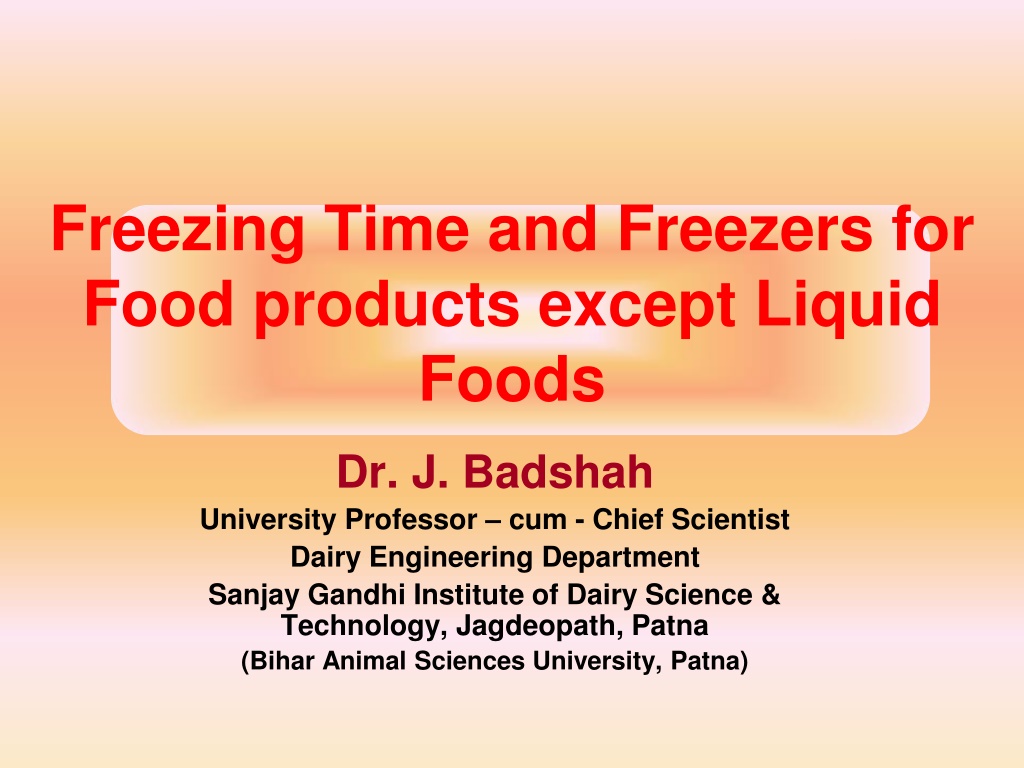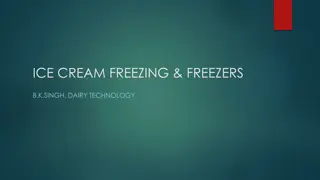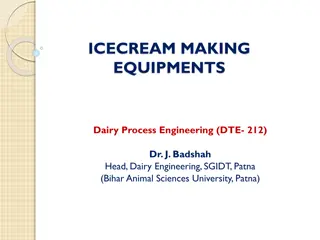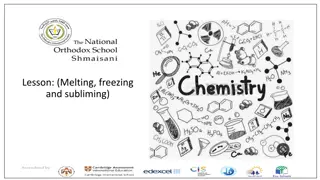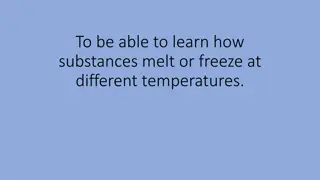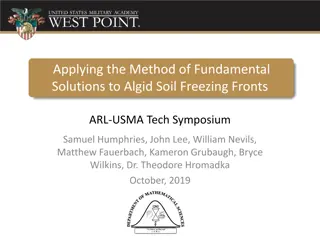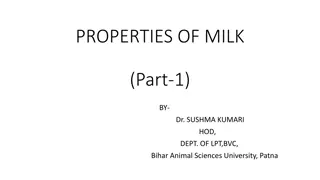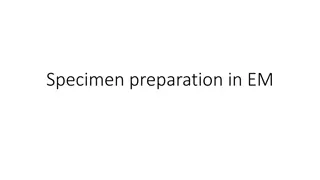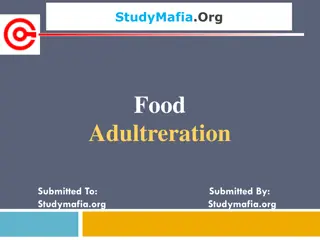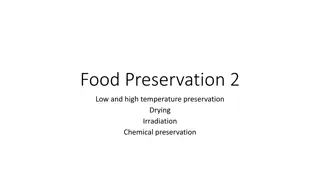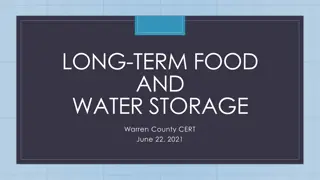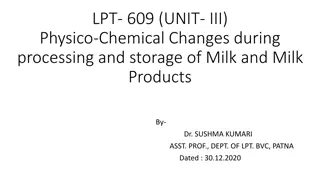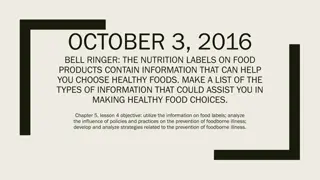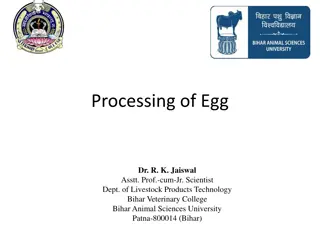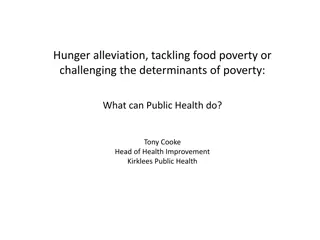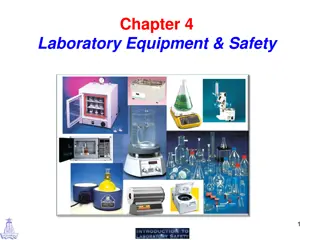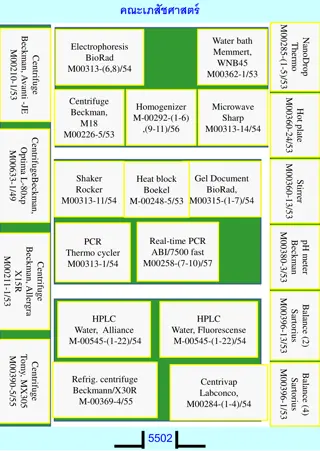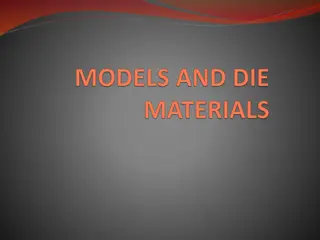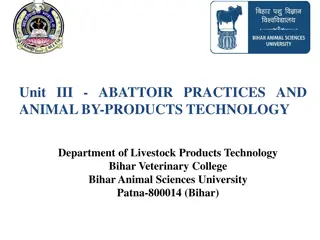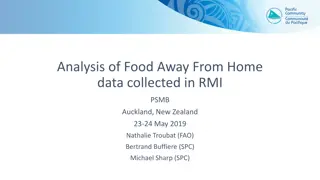Understanding Freezing Time and Freezers for Food Products
Importance of freezing time in the design of freezers is crucial for maintaining food quality during storage. Plank's equation is used to calculate freezing time based on various parameters. Limitations and assumptions of the equation need to be considered for accurate results.
Download Presentation

Please find below an Image/Link to download the presentation.
The content on the website is provided AS IS for your information and personal use only. It may not be sold, licensed, or shared on other websites without obtaining consent from the author. Download presentation by click this link. If you encounter any issues during the download, it is possible that the publisher has removed the file from their server.
E N D
Presentation Transcript
Freezing Time and Freezers for Food products except Liquid Foods Dr. J. Badshah University Professor cum - Chief Scientist Dairy Engineering Department Sanjay Gandhi Institute of Dairy Science & Technology, Jagdeopath, Patna (Bihar Animal Sciences University, Patna)
Importance of Freezing Time in Design of Freezers Freezing times are basic design criteria for freezing systems and represent the residence time for the food product within the freezing system required to achieve the desired level of freezing. The most widely accepted definition of freezing time is the time required to reduce the product temperature from some initial magnitude to an established final temperature at the slowest cooling location. An alternative definition changes the endpoint to the mass average enthalpy equivalent to the desired final temperature for the product. Freezing-time calculations are completed as a first step in the design of a food freezing system. The final product temperature is established as the magnitude needed to maintain optimum product quality during storage. The design of length, height and width of Freezing systems with respect to speed of conveyors and residence time with additional space for handling is considered.
Planks Equation for Freezing Time The most straight forward expression available for computing freezing time was derived by plank. The Plank equation can be derived for various geometries of product. Freezing Time tf = { H . f/(Tf Tm)} {P. a/ hc+ R. a2/ Kf} , where H = Latent heat of freezing at Tfi.e. Initial Freezing Temperature Tm= Cool air or Medium temperature a = Thickness of slab of freezing product hc= Film heat transfer coefficient Kf= Thermal conductivity of Frozen Portion of product P & R are constants depending upon shapes of Products which can be observed from chart and graph.
Limitation & Assumptions of Plank Equation Limitations One of the concerns is selection of a latent heat magnitude (L) and an appropriate value for the thermal conductivity (k). In addition, the basic equation does not account for the time required for removal of sensible heat from unfrozen product above the initial freezing temperature or for removal of frozen product sensible heat. Assumptions Use of equation requires assumption of some latent heat value and doesn t consider the gradual removal of latent heat. The equation utilized only the initial freezing point and neglects the time required to remove sensible heat above the initial freezing point. The initial and final temperature is not accounted for in the equation.
Assumptions of Plancks Equationcontd. Heat transfer takes place sufficiently slowly for steady state conditions to operate. The freezing front maintains a similar shape to that of the food. There is single freezing point. The density of food doesn t change as density values for frozen foods are difficult to measure. The thermal conductivity and specific heat of the food are constant when unfrozen and then change to a different constant value when the food is frozen. Constant thermal conductivity is assumed for the frozen portion.
Factors affecting the design and Selection of Freezers Freezing rates and Freezing time Controlled by operating variables such as temperature difference, type of cooling medium, pressure and velocity of cooling medium such as refrigerant or cooled air Controlled by maintaining large convective heat transfer coefficient and thereby short residence time. Classification & selection of Freezers The contact between cooling medium may be direct or indirect contact The mode of heat transfer such as air contact, refrigerant indirect contact, cryogenic immersion system Batch type system and continuous operation systems Selection among (i) Air Blast Freezers, (ii)Individual quick freezers (IQF), (iii) Plate freezers and (iv)Immersion freezers .
Air Blast Freezers Cooled air blast in direct contact or with a barrier of thin package films i.e. indirect contact products for desired residence time Cooling Medium : Types : (i) Still air freezers and (ii) Forced air freezers. Still air freezers: The unprocessed products with high density and large packages like bulk of meat and fishes are placed in freezer rooms known as sharp freezers in which the cool air is passed at low velocity as if the air is still and surface heat transfer coefficient is low. It takes large freezing time but cheapest methods on large size bulk of products. The freezing time depends on the temperature of the freezing room and size of products. Air circulation by Natural convection
Air Blast Freezers Forced Air Freezers: Forced draft fans in forced air freezers increase convection heat transfer coefficients and reduce the freezing time. The freezing time can be calculated from Plank s equation or its modified form for higher accuracy. The conveyors may be spiral belt conveyors, roller conveyors or tray conveyors. The movement of refrigerated air may be horizontal due to unmeshed conveyor configuration. In batch type mode, the freezing time is longer due to low air speeds, smaller temperature difference and improper contact between air and product within the limit of economical feasibility for bulk of products.
Continuous Air Blast Freezers The continuous air blast freezers are designed with the use of moving conveyors for carrying the products through a stream of high velocity cooled air with the vapour compression cycle refrigeration system. The speed of the conveyor and length of passage or tunnel decided the residence or freezing time. The freezing time can be controlled by temperature gradient, convective heat transfer coefficient and velocity of air stream over the surface of the products. In case of packaged food, Overall heat transfer coefficient can be calculated by expression i.e. 1/U = 1/h + xp/Kpwhere, xpand Kpare thickness and thermal conductivity of packing material.
Individual/Instant Quick Freezers (IQF) The system is designed to achieve low freezing time and rapid freezing, it is referred as Individual quick freezing or IQF. With the ambition of quick and rapid freezing, the cooling medium used in these freezers are low pressure liquid refrigerants with phase change or high speed low temperature air in direct contact. The products are of small sizes, specific geometries, low density and high surface area. If the density of the product such as fruits, dry fruits, vegetables is such that it can be fluidized using vertical flow velocity of cooled air through mesh conveyors at optimum power requirement, the air blast freezers are modified to freezers and are called as Instant Quick freezers (IQF).
Immersion Freezers It is also a direct contact type freezer. The general refrigerants used are liquid nitrogen, liquid carbon dioxide, and Freon. The boiling points of liquid nitrogen, CO2an Freon are 196 C, -98 C and -30 C at atmospheric pressure. It is also known as cryogenic freezing used for improving the quality of products. The efficiency of the system lies in overcoming the defects of loss of refrigerant vapors by recovering the and reuse of the refrigerant vapors again as liquid phase. For typical small size products, the system is designed to immerse the product in liquid refrigerant boiling at very low temperature in a container either in batch or continuous system. In batch system, the frozen products can be portably conveyed to the locations at long distances such as frozen artificial semen container using liquid nitrogen refrigerant.
Plate Freezers The liquid refrigerant at low pressure boils inside the plate and indirectly heat transfer takes place between products to refrigerant. Single plate system results in reduced capacity and low convection heat transfer coefficient due to no pressure. In case of doubled plate, the pressure is applied and heat transfer rate i.e. freezing rate is increased between plate and product. The product may be packaged or unpackaged depending upon requirement. It can be operated as batch or continuous system. The plates can be moved in upward or across direction within the compartment. The total time required is freezing time including entry and exit times.
Numericals on Freezing Time A block of lean meat is being frozen in a -30 C Convection Freezer (hc= 30 W/ sq. m. K). The initial temperature is 5 C and dimension of the product are 1 m by 0.25 m by 0.6 m. The moisture is 74.5 % and IFT is 1.75 C. Given: Density = 1050 kg/m3, Latent Heat = 333.22 x0.745, Thermal conductivity of frozen product Kf = 1.108 W/m. K and shape factors P = 0.3 and R =0.085. Use Plank equation : Freezing Time tf = { H . f/(Tf Tm)} {P. a/ hc+ R. a2/ Kf} Freezing Time = 18.7 hr
Numerical on IQF Design An IQF tunnel is being used for strawberries. The product conveyor is 1.5 m wide and 6 meter long. The air used as a freezing medium is at -34 C and moves through the product bed at a velocity which produces heat transfer coefficient of 85 W/ sq. m. K. If the strawberries enter the tunnel at 5 C and are frozen to -20 C. Compute the Conveyor velocity and estimate the capacity of the freezer. Given: latent heat = 342 KJ/kg, density = 960 kg/ cu. M., dia of straw berry a = 0.013 m, Kf = 2.08 W/m. K., P = 1/6 and R =1/24. Sol. Tffrom Plank Equation: Freezing Time tf = { H . f/(Tf Tm)} {P. a/ hc+ R. a2/ Kf} Freezing time = 4.05 minutes Velocity of the conveyor = Length 6.0 / Residence time 4.05 = 1.5 m/min The Number of straw berries width/0.013)x(1/0.013)= 8846 berries/m The quantity of strawberries per meter length of conveyor + 8846x 4/3 (a/2)3xdensity = 9.77 kg/meter length The capacity of the freezer 9.77 x 1.5 = 14.65 kg/min= 879 kg/ hr per meter length= (1.5 m
